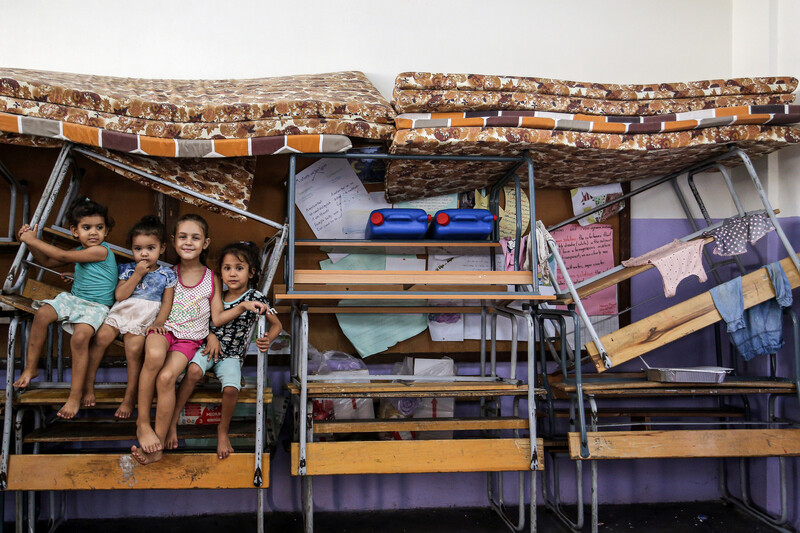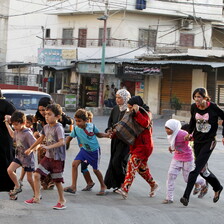The Electronic Intifada 2 October 2023

Children find refuge on 11 September in an UNRWA school after thousands fled recent fighting in Ein al-Hilweh, Lebanon’s biggest Palestinian refugee camp.
Picture-Alliance/DPAAfter months of intermittent but deadly clashes and failed ceasefire agreements, mid-September saw yet another such truce agreed in the Ein al-Hilweh refugee camp in Southern Lebanon.
I hurried there on 16 September to take advantage of the calm between the Fatah movement and al-Shabab al-Muslim, an umbrella group for a number of Palestinian Salafist factions in the camp.
As usual, I handed in my ID card to one of the Lebanese soldiers stationed at al-Nabaa checkpoint, one of seven checkpoints that one must pass to enter a camp that is under close Lebanese military control.
With a wave of his hand, the soldier indicated to me to open the iron gate.
Inside, I was welcomed by Abdel Rahman al-Safadi, 60, the father of a friend. I immediately noticed the large tarpaulins that had been stretched across the camp’s alleys in various locations as demarcation lines, establishing clearly which factions hold sway in what territory.
The recent wave of conflict has swept through several areas of the camp, many of which are named after villages and towns in Palestine where camp residents originated. Among these, Hittin and Tawari were hardest hit and off-limits to journalists and civilians, since the warring factions had designated them as military zones.
Al-Safadi resides in the Ras al-Ahmar area. The refugees in this area are descendants of those who were forcibly exiled in 1948 from the village of Ras al-Ahmar, located to the north of Safad in what is now northern Israel.
The neighborhood, which had been spared in the many previous rounds of clashes that the camp has endured over the years, this time found itself a battleground. But al-Safadi and the men of the area collectively decided they would not leave their houses.
“Now you will only see men. All women and children evacuated the camp, but we decided to remain. If we were to abandon our homes, fighters would seize them, converting them into makeshift barracks,” al-Safadi told The Electronic Intifada. “There have been instances where they’ve looted deserted homes. This is why I stayed.”
Marking territory
As we moved deeper into the alleyways of the area, the destruction became more evident. Parts of the area were unrecognizable from previous visits. Walls were riddled with bullet holes, multistory buildings bore the scars of artillery strikes, and some homes had been reduced to rubble. At one point, my foot disturbed a substantial pile of spent bullet casings.
“This is just a fraction of what was here,” al-Safadi remarked. “During the ceasefire, kids collected most of them. They sell the casings for recycling to earn some money.”
Some residences sported large gaps in the walls, as fighters punched their way from house to house in a bid to move while avoiding the gunfire they would attract had they emerged into the open.
Al-Safadi said the holes in this area had been made by Fatah fighters. Another man, who identified himself only as Abu Ahmed, interjected.
“We can tell it’s the work of Fatah and not the Islamists, because the Fatah guys deliberately leave their flags behind,” the 65-year-old said as he insisted on showing me the holes they had made in two walls in his house and the flags they had left behind.
Unlike other areas of the camp – or indeed other refugee camps in Lebanon – where it is customary that certain neighborhoods tend to collect people from the same factions, and are thus dominated by those factions, Ras al-Ahmar was not aligned until 2019.
However, during a round of clashes that year, some Fatah fighters established a base in a house in the area. This sparked significant discontent among the civilian residents.
It is normally deemed highly inappropriate for an armed faction to set up within civilian areas and their narrow alleyways, as opposed to the more open areas where different factions usually have their offices.
This is mainly due to the presence of young armed cadres stationed on the streets, some of whom have been known to harass women or create disturbances. With houses in close proximity, the presence of armed men on the streets also invades people’s privacy.
Muhammad al-Hajj, 54, who was accompanied by his two young children, took me to the building where he and his extended family reside – or used to. As we ascended to the second floor where an uncle, Ali al-Hajj lived, we saw a gaping hole in the wall near the stairs, a grim testament to an artillery strike. The second floor, once filled with memories and possessions, has been reduced to rubble.
And with the first floor also damaged, the family has sought refuge with relatives outside the camp.
“This was once a beautiful home,” al-Hajj said with some emotion. “My uncle invested everything here. Who will compensate us? The future is uncertain, and living in this limbo is excruciating. It’s not as if we can simply buy a new house.”
Control by proxy
Palestinians in Lebanon’s refugee camps have long been caught in the crossfire of political power struggles among various Palestinian factions. Many of these groups emerged after the departure of the Palestine Liberation Organization (PLO) from Lebanon in 1982, leaving behind a large Fatah movement and a number of smaller factions.
Fatah remains the dominant faction within the PLO, where opposition groups like Hamas and Islamic Jihad are still not represented, and it has consistently sought to extend its influence across the Palestinian camps in Lebanon.
Its primary focus has been on Ein al-Hilweh, Lebanon’s largest Palestinian camp, in a bid to consolidate its self-appointed status as the main legitimate representative of the Palestinian people.
However, this isn’t the sole motivation. The Fatah-dominated Palestinian Authority in the occupied West Bank views Lebanon’s Fatah faction as the PA’s representative in the camps.
For years, and as part of this drive, senior PA/Fatah leaders, like Mahmoud Abbas, the head of both Fatah and the PA, and Azzam al-Ahmad, a senior Fatah member of the Palestinian Legislative Council, have advocated that all factions in the camps should be disarmed. They propose instead the establishment of a Palestinian police force to oversee camp security, operating directly under PA/Fatah guidance.
This is an important part of the reason for the clashes in the various camps in Lebanon. Camp residents and political factions largely perceive the PA as an instrument of the Israeli occupation, and consider the drive to disarm the camps as a way for Israel to to control the camps by proxy.
The deployment in Ein al-Hilweh on 29 September of a security force composed of fighters from factions not involved in the recent fighting has therefore been greeted with some optimism that this time the ceasefire might just last.
School’s out
Something had to be done. The clashes have had catastrophic consequences. Some 4,000 people have been forced to evacuate their homes. In addition, fighters from different factions remain stationed in five of the eight UNRWA schools in the camp, according to camp residents, disrupting the start of the school year and potentially canceling the entire academic year for their nearly 6,000 students.
Mahmoud, 12, and Akram,10, who accompanied me for some of my visit, said they were initially happy when gunmen took over their school.
“We thought, great! More holiday! But now I am really sad,” Mahmoud said. “I don’t want my school to be destroyed, that’s where I play with my friends. Also, I want to learn. If I don’t learn enough I will end up like the fighters, that’s what my father says. I do not want that. I want to free Palestine with my education, not by destroying the camp.”
Their father has a point. As I wandered through areas under Fatah control, I encountered a young man, no older than 20, seated on a chair with a rifle resting on his lap, enjoying a plate of courgettes with yogurt, or kousa be laban. Our eyes met, and we exchanged smiles.
The young man fits the typical profile for a fighter in the camps. An OCHA report from 2017 found that 65 percent of Palestinians in Ein al-Hilweh live below the poverty line. The same report noted an eight percent rise in unemployment from 2010 to 2017, for a total of 23 percent.
Since that report, Lebanon has grappled with severe economic crises affecting its entire population and leaving refugees even more socio-economically vulnerable. The country has suffered the Covid epidemic, while UNRWA has seen donations to the agency drop so alarmingly, the agency head Philippe Lazzarini just this month described the situation as “absolutely unbearable.”
With a lack of prospects, a faltering economy, donor fatigue and no political horizon for Palestine, the youth of Lebanon’s Palestinian camps, like the courgette-eating guard I encountered in Ein al-Hilweh, will often feel they have little choice but to join armed factions, sometimes for as little as $200 a month.
Amena ElAshkar is a journalist and photographer based in Beirut.





